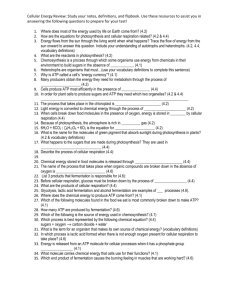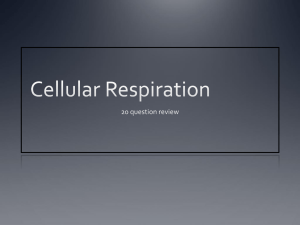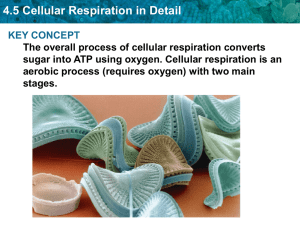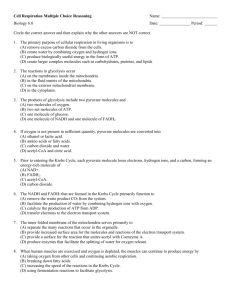Cellular Respiration Guided Notes
advertisement
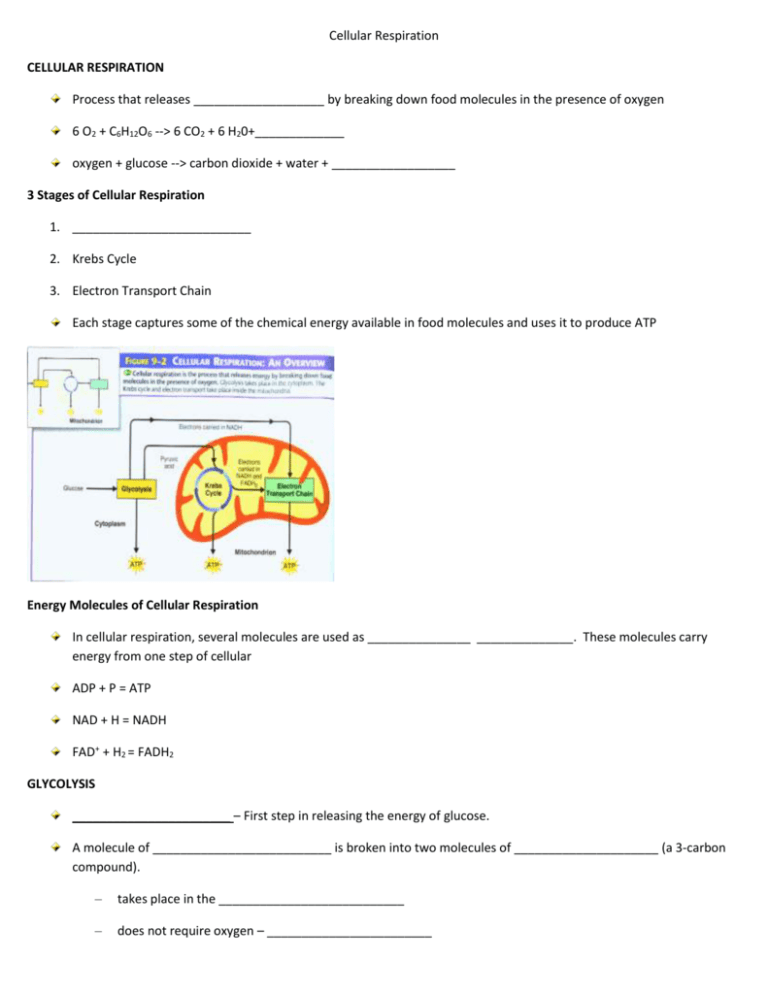
Cellular Respiration CELLULAR RESPIRATION Process that releases ___________________ by breaking down food molecules in the presence of oxygen 6 O2 + C6H12O6 --> 6 CO2 + 6 H20+_____________ oxygen + glucose --> carbon dioxide + water + __________________ 3 Stages of Cellular Respiration 1. __________________________ 2. Krebs Cycle 3. Electron Transport Chain Each stage captures some of the chemical energy available in food molecules and uses it to produce ATP Energy Molecules of Cellular Respiration In cellular respiration, several molecules are used as _______________ ______________. These molecules carry energy from one step of cellular ADP + P = ATP NAD + H = NADH FAD+ + H2 = FADH2 GLYCOLYSIS _______________________ – First step in releasing the energy of glucose. A molecule of __________________________ is broken into two molecules of _____________________ (a 3-carbon compound). – takes place in the ___________________________ – does not require oxygen – ________________________ GLYCOLYSIS Requires: 1 Glucose molecule (C6H12O6), 2 ATP Produces: 2 ATP, 2 NADH and 2 pyruvic acid Second Stage: Fermentation or Krebs Cycle Glycolysis can be followed by ___________________________ or the Krebs cycle depending if _________________ is present. – ______________________________ will occur if no oxygen is present. – _____________________________ will occur if oxygen is present. Without Oxygen – Fermentation _____________________________ - without the presence of oxygen Fermentation - releases energy from food molecules in the ______________________ of oxygen two types: ______________________________ and Lactic Acid Fermentation Occurs in the _________________________ Types of Fermentation _______________________ - causes bread to rise, used to make beer and wine _______________________ - produced in muscles during rapid exercise when body can’t supply enough O2 – causes painful, burning sensation and muscle soreness With Oxygen - Kreb’s Cycle Aerobic - in the presence of _________________________ Kreb’s Cycle also called _____________________________________ ________________________ - 2nd stage of cellular respiration, in which pyruvic acid is broken down into CO2 in a series of energy-extracting reactions, creating energy molecules. – Occurs in the ______________________________ Kreb’s Cycle Requires: 1 Pyruvic Acid Produces: CO2, NADH, FADH2, ATP Kreb’s Cycle As a pyruvic acid molecule enters the __________________________, a carbon is removed, forming CO2. Carbons continue to be rearranged, releasing more CO2, while allowing the energy carriers to be charged. This cycle will happen twice for every molecule of _______________________ broken down in glycolysis. Third Stage: Electron Transport Chain The electron transport chain uses the high-energy electrons from the Krebs cycle to convert _____________ into ________. – Occurs in the mitochondrial matrix. Electron Transport Chain (ETC) Requires: NADH, FADH2, ADP Produces: H2O, NAD, FAD, ATP Electron Transport Chain 1. The ________________________________ generates high-energy electrons that are passed to NADH and FADH2. 2. The high-energy electrons (H+) from NADH and FADH2 are used up and passed along the proteins in the __________. 3. _____________________ serves as the ________________ electron acceptor forming a water molecule. 4. As H+ ions move through the ETC, _________ ______________________ spins adding ADP to P forming ________. Cellular Respiration Totals ______ molecule of glucose produces: – 2 ATP in _____________________________ – 34 ATP in Kreb’s Cycle and Electron Transport Chain – water – CO2 Types of Energy Quick Energy - ________________ only contain enough ATP for a few seconds of intense activity. Then, muscle cells produce their ATP by lactic acid fermentation. __________________________________ - Cellular Respiration is the only way to generate a continuing supply of ATP – energy is released more slowly than fermentation, which is why athletes have to pace themselves – 15 to 20 min. of activity from carbohydrate stored in the body – after 20 min., energy comes from break down of fats Photosynthesis vs. Respiration Photosynthesis and cellular respiration take place in opposite directions! Photosynthesis: Use light energy to build a sugar. carbon dioxide + water + light energy → sugars + oxygen Respiration: Break down sugar to release energy. oxygen + sugars → carbon dioxide + water + energy Photosynthesis vs. Respiration Photosynthesis: – Use light energy to build a sugar. – Process that “deposits” or captures energy. – Removes carbon dioxide from the atmosphere. – Releases oxygen into the atmosphere. Photosynthesis vs. Respiration Respiration: – Break down sugar to release energy. – Process that “withdraws” or releases energy. – Removes oxygen from the atmosphere. – Releases carbon dioxide into the atmosphere.
